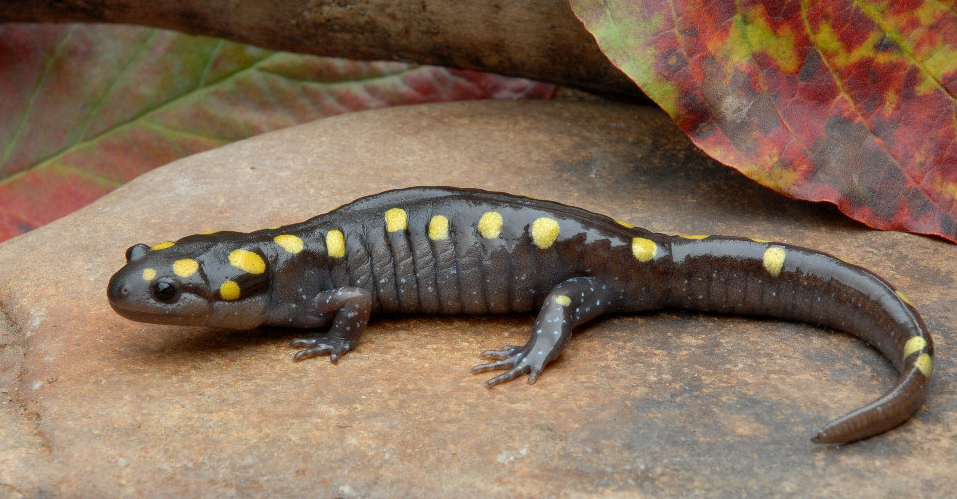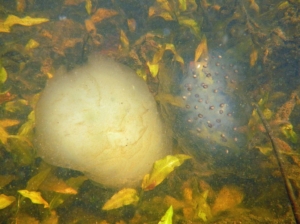SCORES & OUTDOORS: Interesting weekend of various animals’ activities

spotted salamander
 by Roland D. Hallee
by Roland D. Hallee
It was an interesting weekend for me regarding unusual animal activities. The first one was actually, unknowingly, transporting a field mouse from our camp to our house. She had hidden herself in some clothes that were taken home to be laundered, jumped out of the bag and ran under the refrigerator. She is still at large, but left behind five recently-born babies. The hunt continues.
What we didn’t realize, at the time, was that the mouse had made its nest in the bag of clothes that was left in camp over the winter. Lesson learned. Won’t do that again.
The second, while preparing Sunday dinner, I actually witnessed a squirrel fall out of a tree. Never seen that before. It fell onto a wood pile, and lay motionless for a couple of minutes. I thought it was dead, but apparently was only stunned. It eventually regained its wits, shook off the dizziness, and proceeded along its way. A little bizarre to say the least. Have you ever seen a squirrel fall from a tree?
The most interesting one, though, happened at camp on Sunday. Our neighbor, while raking winter remnants of leaves and twigs, discovered a weird-looking lizard. She brought it to me, and we inspected it. It lay quietly in her hand as she slowly and gently petted it. We tried to discern what it was. She found it among some rocks that had been concealed with leaves.
It was about seven inches long, and black with bright yellow spots. It resembled a salamander – you know the little red ones we see running around under wet rocks or boards. Only, compared to those salamanders, this one looked like Godzilla.
Well, research revealed it to be a spotted salamander, a mole salamander that is common in the eastern United States and Canada.
For about 95 percent of the year, these shy creatures bury themselves under logs, leaves and rocks, or in burrows and tunnels made by other animals. They remain dormant during the day, emerging at night to feast on insects and other invertebrates. They spend most of their time underground. They rarely come above ground, except after a rain or for foraging and breeding. During the winter, they hibernate underground, and are not seen again until breeding season in early March to May.
Vernal pools are very important to the spotted salamander. They may visit them only for a few days each year, but they are crucial in the amphibian’s life cycle.
Although common, vernal pools are not well understood. It’s easy to pass by one of those and not even know it’s there. Vernal pools are a temporary, isolated pool of water. They typically fill in between the winter and spring and dry up by late summer. It is impossible for fish to survive in them, making the vernal pool ideal for the amphibians’ reproduction. Eggs and larvae of the amphibian are a very tasty treat for hungry fish.
Usually between mid-March and the end of April they migrate en masse to their local vernal pool. Once there, they participate in a nuptial dance so vigorous that the water around them may appear to boil. That is when mating occurs. A few days later, females will lay upwards of 100 eggs. The adults then depart to their forest hideouts, leaving the young to fend for themselves.
Within the northeastern United States, several states have already listed the spotted salamander as a species of special concern. This is mostly because many vernal pools, especially in urban areas, are being destroyed by development. This puts the spotted salamander in peril.
The spotted salamander is approximately 6 – 10 inches long. They are stout, with a wide snout. The main color is black with two uneven rows of yellow spots running from the top of the head to the tip of the tail. The spots closest to the top of the head are more orange, and change to more yellow by the end of the tail.
The diet of the adult spotted salamander includes crickets, worms, insects, spiders, slugs, centipedes, and millipedes.
The little guy my neighbor disturbed seemed to be a little groggy. Maybe it’s because he was roused from his day time siesta. She put it back where she found it, hopefully, no worse for the wear.
Roland’s trivia question of the week:
In 2009, the Red Sox recorded a MLB first when they had four Japanese-born players on their roster. How many can you name?
Responsible journalism is hard work!
It is also expensive!
If you enjoy reading The Town Line and the good news we bring you each week, would you consider a donation to help us continue the work we’re doing?
The Town Line is a 501(c)(3) nonprofit private foundation, and all donations are tax deductible under the Internal Revenue Service code.
To help, please visit our online donation page or mail a check payable to The Town Line, PO Box 89, South China, ME 04358. Your contribution is appreciated!



Leave a Reply
Want to join the discussion?Feel free to contribute!